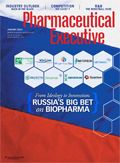Biosimilars or Bust
Where are the biosimilars to help cut costs as the first wave of biologics, or complex, small molecule respiratory drugs, for example, go off patent? They've arrived in Europe, but the U.S. lags...
For years now, the increased spend on healthcare in the U.S. hasn't evenly correlated with better health outcomes for patients. Despite spending more on healthcare than any other country in the world, the U.S. still trails most developed markets in cost-driving disease areas like heart failure and unmanaged respiratory disease. Citizens of over 20 countries can expect to live longer than Americans. In the U.S., taxpayers aren't getting the outcomes for which they've paid.
As anyone working in the drug industry is quick to point out, spending outlays for pharmaceuticals represent only a tenth of the total healthcare spend; actually 9.3% of the total spend in 2012, according to a September 2013 report from the Office of the Actuary at CMS. But that 9.3% is equivalent to $260.8 billion: not exactly pocket change. While a lot of blockbuster drugs lost patent protection in the last few years, and have become available in generic form at a fraction of the price (this fact accounts for the year-over-year decline of 0.8%, to 9.3% of total health spend in 2012), a lot of new drugs are getting approved and launched with bold price tags, and most of them are biologic drugs.
Where are the biosimilars to help cut costs as the first wave of biologics, or complex, small molecule respiratory drugs, for example, go off patent? They've arrived in Europe, but the U.S. lags, in part because biologics patents live longer in the U.S. (unlike its citizens). GSK's Advair, a combination inhaler for asthma and COPD, earned over $8 billion in 2012. It lost patent protection in 2010 and isn't even a biologic drug; it's a small molecule product with a complex, patent-protected inhaler device. To achieve biologic equivalence, FDA in many cases must issue product-specific guidance to inform manufacturers what new clinical trials will be necessary for approval.
That determination – what kind of trials are required, and how many – represents a cost barrier to entry. Many would-be manufacturers simply don't have the resources to successfully develop biosimilars given the cost of clinical trials. On top of that, a biosimilar launch doesn't resemble the flood of generic tablets that follow a small molecule patent expiry. Brand-like commercial teams are needed to educate physicians about new biosimilars, and to drive utilization.

Switzerland-based Sandoz, a division of Novartis, currently has several biosimilar products in phase 3 trials. The company is targeting some of the world's biggest selling products: AbbVie's Humira, Amgen's Enbrel, and Roche's Rituxan. But without the financial backing of parent Novartis, "it would be hard for Sandoz to invest at the level we're investing today," Ameet Mallik, Sandoz's head of biopharmaceuticals and oncology injectables, tells Pharm Exec. Mallik says Sandoz has learned a few things about launching biosimilars based on experience with its "first wave" products including Zarzio, Binocrit and Omnitrope, also known as biosimilar versions of Neupogen, Procrit and Genotropin, respectively. For the company's next wave of biosimilars, "especially the monoclonal antibodies," Sandoz will "take a more branded approach than when we launched the biosimilars in the first wave," says Mallik.
When he took over the business in late 2009, says Mallik, Sandoz and its competitors were "treating [biosimilars] very much like a generic market...if we lower the price, somehow the products will sell themselves." With Omnitrope, a human growth hormone product (approved in the US in 2006, via the 505(b)(2) pathway), Sandoz grew its market share against branded products from 5% to 17% in four years, due to a scale up in field forces, and an increase in its service offering to patients and physicians, says Mallik. Initial access is important, but biosimilar companies also have to "make sure the physician education and training for patients is as good or better than what the original [brand] company was doing," says Mallik.
Combine a robust commercial function with a costly manufacturing and clinical trial capability, and you get a product that needs to charge more than cents on the dollar. "Each one of these [biosimilar] molecules is $100 to $250 million in development costs, over seven to eight years," says Mallik. "Your payback periods are going to be long." Given that the biosimilars market is worth roughly $2.7 billion in 2013, but is expected to climb to nearly $20 billion by 2018, it seems unlikely that health systems, in the U.S. and elsewhere will see a dramatic decline in the overall cost of prescription drugs due to biosimilars.

Ben Comer is Pharm Exec's Senior Editor. He can be reached at bcomer@advanstar.com.
Amgen’s Imdelltra Demonstrates Significant Overall Survival Improvement in Small Cell Lung Cancer
April 16th 2025In the Phase III DeLLphi-304 trial, patients with small cell lung cancer administered Imdelltra achieved a statistically significant and clinically meaningful improvement in overall survival compared to standard-of-care chemotherapy.
Addressing Disparities in Psoriasis Trials: Takeda's Strategies for Inclusivity in Clinical Research
April 14th 2025LaShell Robinson, Head of Global Feasibility and Trial Equity at Takeda, speaks about the company's strategies to engage patients in underrepresented populations in its phase III psoriasis trials.
Key Findings of the NIAGARA and HIMALAYA Trials
November 8th 2024In this episode of the Pharmaceutical Executive podcast, Shubh Goel, head of immuno-oncology, gastrointestinal tumors, US oncology business unit, AstraZeneca, discusses the findings of the NIAGARA trial in bladder cancer and the significance of the five-year overall survival data from the HIMALAYA trial, particularly the long-term efficacy of the STRIDE regimen for unresectable liver cancer.
Odylia Rare Disease Day Event Highlights Challenges in R&D for Orphan Drugs
April 14th 2025Odylia Therapeutics event brings together leaders across biotech, pharma, venture capital, patient advocacy, and research sectors to address the financial and structural barriers that impede rare disease drug development.
